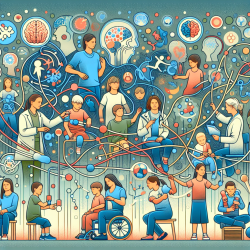Introduction
In the realm of special education, understanding the intricacies of developmental disorders such as Developmental Coordination Disorder (DCD) and Attention-Deficit/Hyperactivity Disorder (ADHD) is paramount. A recent study titled "Functional connectivity of neural motor networks is disrupted in children with developmental coordination disorder and attention-deficit/hyperactivity disorder" sheds light on the neural disruptions that underlie these conditions. This research not only advances our comprehension but also offers practical insights for practitioners aiming to enhance their therapeutic strategies.
The Study at a Glance
Conducted using resting-state functional magnetic resonance imaging (rs-fMRI), the study examined the functional connectivity of the primary motor cortex in children with DCD, ADHD, and co-occurring DCD and ADHD, compared to typically developing controls. The findings revealed significant disruptions in the motor networks of affected children, highlighting common neurophysiological substrates that may underlie both motor and attention problems.
Key Findings and Implications
- Children with DCD and/or ADHD exhibited reduced functional connectivity between the primary motor cortex and several brain regions, including the bilateral inferior frontal gyri, right supramarginal gyrus, and insular cortices.
- These disruptions suggest that motor and attention problems may share common neurophysiological substrates, potentially guiding future diagnostic and therapeutic approaches.
- Age-related patterns of connectivity differed between affected children and controls, indicating that these disorders might impact brain development differently over time.
For practitioners, these insights underscore the importance of early identification and intervention. By understanding the neural basis of these disorders, therapists can tailor interventions that specifically target the disrupted networks, potentially improving motor and cognitive outcomes for affected children.
Practical Applications for Practitioners
Practitioners can leverage these findings to refine their therapeutic approaches:
- Targeted Interventions: Develop interventions that focus on enhancing connectivity in the disrupted motor and cognitive networks.
- Early Screening: Implement screening tools that assess motor and attention functions, allowing for early intervention and support.
- Collaborative Approaches: Work closely with neuroimaging specialists to integrate findings into comprehensive care plans.
Moreover, practitioners are encouraged to engage in further research to explore the implications of these findings and to contribute to the growing body of knowledge in this field.
Conclusion
The study provides a compelling case for the interconnected nature of motor and attention disorders, emphasizing the need for integrated therapeutic strategies. As special education practitioners, we have the opportunity to harness these insights to foster better outcomes for children with DCD and ADHD. By bridging the gap between research and practice, we can unlock the potential of every child, ensuring they thrive in their educational journey.
To read the original research paper, please follow this link: Functional connectivity of neural motor networks is disrupted in children with developmental coordination disorder and attention-deficit/hyperactivity disorder.










